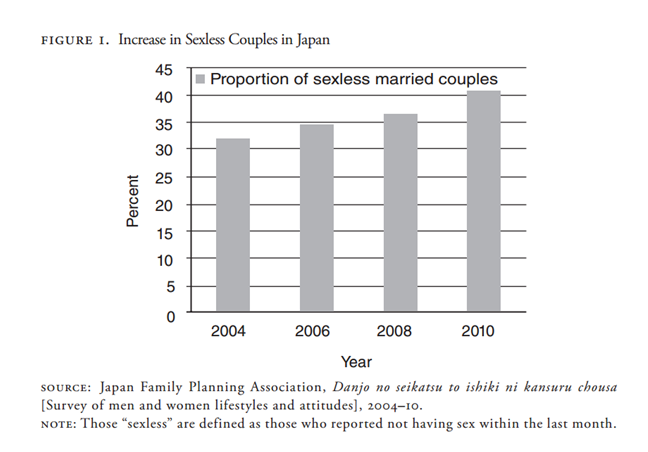
By 2060, Japan will have a population of 86.7 million, from today’s population of 125 million (Yamaguchi, 2022). The population will also grow older. This trend has been going on since the 1970s, when experts first began to write about the decline (Date, 2007).
Why is this a problem? After all, fewer people means more access to resources for each person. However, as the population declines, a significant portion of the population will be older. This drives up social security costs, and Japan is already deep in governmental debt. Tax dollars decline and generational rifts may develop between those of working age and the elderly who depend upon them. The elderly may be blamed for the problems of society or even as “predators of the common good” (Kavedzija, 2016). Fewer younger people will be around to give the elderly care. Kavedzija (2016) accounts of an interview:
Hashimoto san, for example, is a lively lady in her early 60s, herself childless but maintaining a wide network of friends and acquaintances on whom she would be able to rely in times of need. She spoke with a sense of urgency about what she felt to be the hopelessness of the situation of young people: ‘When we were young, we knew that our salaries would rise, we could buy a house ( . . . ) and there was a sense that everything was going to go well. Young people today don’t have that. They have no hope (kibou).’
And as the population grows older, the solutions become politically harder because the older population resist change. Lam (2009) outlines the solutions of Japan’s population problem. However, all of these solutions see resistance among Japan’s elderly voters:
- Support immigration
- Support working mothers
- Increase elderly and female participation in the workforce
- Reform the pension system
- Raise consumption tax
- Corporations need to participate in these reforms
Lam goes on: “However, electoral politics which is concerned with the immediate priority of political survival and the enduring norms of Japanese corporations and patriarchal society will mean that Japan is unlikely to solve its looming aging crisis.”
Over the long term, the elderly will pay the price for the population decline as they face more solitude, diminishing quality of life, and less care. And this may well cause them to double-down their resistance to the solutions Japan needs to take. Japan will also lose its standing among the world nations as its economy declines.
Why is Japan’s Population Falling?

Population decline results from many factors, most of which center upon the role and treatment of women in Japanese culture. First, marriage and children remain closely entwined in Japanese culture. Second, Japanese women have been postponing marriage since the 1980s (Date, 2007):
This shows that the decline in the rate of first marriage since the 1980s has been significantly impacted by the trend toward marriage postponement. The rate of first marriage among women in their early twenties fell sharply, and in the late 1980s, the rate of first marriage among women in their late twenties exceeded that of women in their early twenties. Further, the overall rate of first marriage first became linked with the late twenties rather than the early twenties in this time frame.
Date (2007) is careful to note that female workplace participation and the decrease in marriage and fertility remain a correlation and not a causation. Date goes on to cite various Japanese studies from the 1990s. People have been trying to tease out the whys for decades:
An abundance of empirical research uses microdata to examine the relationship between female employment and fertility rates. Shigeno (1996) shows that women’s employment constrains fertility, but that full-time employment exerts more downward pressure than part-time employment on childbirth probability. Matsuura and Shigeno (1996) confirm that when the wife is a white-collar worker, fertility probability is lower in all age groups. This may be attributable to the fact that full-time and white-collar workers have little time to themselves during their working hours.
So far, studies have focused on women, since women bear children. The role of men in Japanese culture doesn’t help matters. Japanese men, traditionally, trade their loyalty and commitment to a company in exchange for lifetime employment. This exchange leaves men largely unable to be home for their families. Combine this with women wanting careers–and men wanting to be home for their families–and you can see why people forego children. There’s no point in having a family if you cannot be home for the family. Children come at a high cost for women–career and freedom. They also come at a high cost for men–longer work hours and the emotional stress of wanting to be present but unable to do so because of work. While the work environment is slowly changing, progress remains slow as the continued low-fertility rate attests. Economics play the largest role in having children–children are expensive, so if a couple already struggles to live, bringing children into the mix would be foolish. Any country that wants to encourage people to have children needs to reduce the cost of living. For those who are into economics, that means the dreaded curse-word: deflation. Wage increases stimulates inflation, after all.
Japan the Canary
Japan shares its population decline with the West. The US and other Western nations have strong immigration trends, which helps offset the decline in fertility, but population still trends toward a holding level or a decline. Over the long term, population will hit a sustainable equilibrium, but where the equilibrium lands remains the question. Future generations of Japanese workers may be paying back the debts of their grandparents and even great-grandparents, depending on how the costs and economy balance. What makes Japan, Japan contributes to its problems. The cultural momentum and vested interests will have to weaken before solutions can be implemented. Progress takes generations sometimes, even when the solutions are simple (if not easy). As Koasi wrote back in 1998:
The fertility rate could also recover if it is supported by labor-market reforms that ease the trade-off between women’s staying on the job and their child-rearing.
Over the long term, a decrease in population may prove to be a boon as technology offsets any declines in production.
Across the decades of research I found, the common themes kept appearing: support women, reduce work hours, improve work flexibility, support immigration, decrease the cost of living. As far as I could tell, since the 1970s, there’s been little concerted effort to implement these reforms. As MacKellar (2000) wrote, “Japan is, therefore, on the frontier of our knowledge of how to adapt to a rapidly ageing population. She must break the path that other nations will follow.”
References
Date, Y., & Shimizutani, S. (2007). Why Has Japan’s Fertility Rate Declined? Japanese Economy, 34(1), 4–45. https://doi-org.oh0164.oplin.org/10.2753/JES1097-203X340101
Kavedžija, I. (2016). The Age of Decline? Anxieties about Ageing in Japan. Ethnos: Journal of Anthropology, 81(2), 214–237. https://doi-org.oh0164.oplin.org/10.1080/00141844.2014.911769
Kosai, Y., Saito, J., & Yashiro, N. (1998). Declining Population and Sustained Economic Growth: Can They Coexist? American Economic Review, 88(2), 412–416.
Lam, P. (2009). Declining Fertility Rates in Japan: An Ageing Crisis Ahead. East Asia: An International Quarterly, 26(3), 177–190. https://doi-org.oh0164.oplin.org/10.1007/s12140-009-9087-y
MacKellar, L., & Horlacher, D. (2000). Population Ageing in Japan: A Brief Survey. Innovation: The European Journal of Social Sciences, 13(4), 413–430. https://doi-org.oh0164.oplin.org/10.1080/13511610020017381
Ohashi, Haruka, et al (2019) High-resolution national land use scenarios under a shrinking population in Japan. Transactions in GIS. 2019;23:786–804.
Yamaguchi, Mari (2022) Japan births at new low as population shrinks and ages. ABC News https://abcnews.go.com/International/wireStory/japan-births-new-low-population-shrinks-ages-94078296.






I think the hope that new technologies would help with Japan’s aging population have ended up as something like the promise of nuclear fusion. The technological hurdles and the costs of development just haven’t made sense economically.
The bigger issue for Japanese society is immigration. Where countries such as the US have padded their own post baby-boom population declines with a constant flow of immigrants, Japanese mono-culture has been slow to accept such a challenge to its sense of order. And many long-term immigrants to Japan eventually find that they hit a sort of glass ceiling in a country where there really isn’t much opportunity to start something new.
Japan’s primary natural resource is its population. So the end will come when young Japanese start choosing to go abroad for careers… something already tangibly visible in places like Singapore.
Do you see the increase of remote, international work accelerating the exodus of Japan’s younger workers?
How do you think these pressures will impact the Japanese language? I read during the Meiji Restoration there was serious thought to adopting romaji as the primary writing system. Do you think population and economic decline may lead to this to ease integration of immigrants?
In Singapore last December, I was a little surprised by the number of young Japanese expats. Many younger American families, too! The reasons I heard were that there’s just more opportunity, and that it’s a better place to raise kids. (Though the schools can become pressure-cookers as the kids get older.)
English is now a mandatory, uni-prep high school subject in Japan. But I don’t know how well it’s actually being taught. My experience is that many can write fairly standard English, but speaking is a problem (I think due to the relative multitude of sounds in English). Regardless, I don’t see Japanese disappearing any time soon… it’s too culturally loaded.